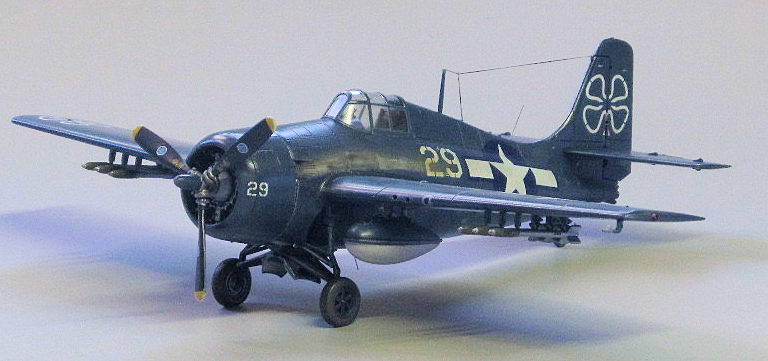
Arma 1/72 FM-2 Wildcat
| KIT #: | 70033 |
| PRICE: | $25.00 |
| DECALS: | Two options |
| REVIEWER: | Ryan Grosswiler |
| NOTES: | Basic kit, not the 'expert' version. |

| HISTORY |
The story of the Grumman F4F Wildcat is a fairly familiar one to most of us; the Grumman fighter which would go down in history as the airplane which held the line in the Pacific until the bigger, badder Hellcat could come along. One would think this simple storyline would have spelled the end for the early fighter when its successor took over its duties, but this was not to be the case: at about the same time the Hellcat was about to reach combat the Navy let a requirement for a lightweight, short-takeoff fighter for use on its growing fleet of small escort carriers, an unexpected need that the heavier Hellcat simply could not meet.
So came the FM-2. The variant actually started life as Grumman's XF4F-8 prototype, lightened and specialized to low-altitude operations. The two-row Pratt & Whitney R-1830 of earlier Wildcats was swapped for the single-row Wright R-1820, the powerplant that had been previously installed for the French order which became the UK's Martlet I. This installation put the engine further forward in a wider but shorter cowl, the new mount and engine's single-stage blower causing a greatly revised internal arrangement in the accessory section. Oil coolers were moved from under the wing center section into the cowl, with the former openings sheeted over. More power at the low end of the performance spectrum and torque on a lighter airframe meant more rudder authority was required, so a bigger, taller tail was incorporated as well—the subtype's defining feature. Firepower was reduced back to the F3F's original four .50s, but provision for six 5" rockets was added in the last production blocks. Though the resulting aircraft at a glance just looked like a Wildcat with a taller tail, there were in reality quite a few differences. As it was already recognized that Grumman had its hands full, production was from the outset subcontracted to Eastern Aircraft—hence the FM-2 designation.
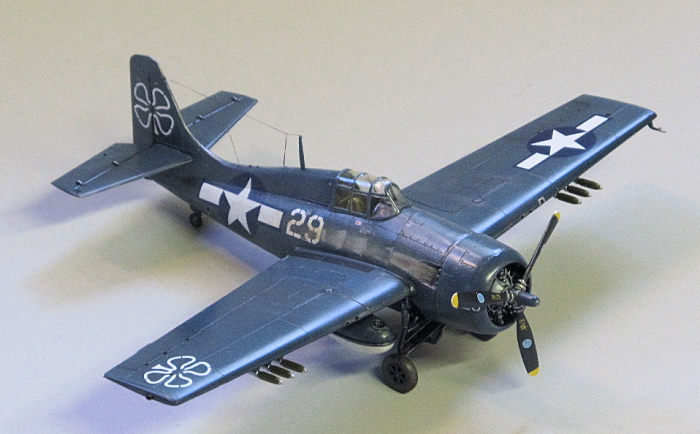 The
new version began deliveries to the Navy in September 1943, reaching the decks
of the escort carriers at the beginning of the following year. Incorporated
mostly into so-called 'Composite' squadrons where it operated alongside Grumman
Avengers in a mixed bag of close air support of amphibious operations,
anti-submarine patrol, and low-level air defense, the new Wildcat quickly proved
itself in combat and freed up the Corsairs and Hellcats operating off the big
fleet carriers to range their operations further out. While not much faster than
the earlier F4F-4, the FM-2 was more maneuverable and had a much better climb
rate. While opportunities to engage the enemy in combat were limited by this
time period and intended mission, FM-2 pilots were nonetheless credited with
hundreds of kills by the end of the war. One pilot, Lt. Ralph Elliot, scored all
nine of his aerial victories on the aircraft. In this way, the habitual belief
that the Wildcat was an inherently "inferior" airplane gets turned upside down.
The
new version began deliveries to the Navy in September 1943, reaching the decks
of the escort carriers at the beginning of the following year. Incorporated
mostly into so-called 'Composite' squadrons where it operated alongside Grumman
Avengers in a mixed bag of close air support of amphibious operations,
anti-submarine patrol, and low-level air defense, the new Wildcat quickly proved
itself in combat and freed up the Corsairs and Hellcats operating off the big
fleet carriers to range their operations further out. While not much faster than
the earlier F4F-4, the FM-2 was more maneuverable and had a much better climb
rate. While opportunities to engage the enemy in combat were limited by this
time period and intended mission, FM-2 pilots were nonetheless credited with
hundreds of kills by the end of the war. One pilot, Lt. Ralph Elliot, scored all
nine of his aerial victories on the aircraft. In this way, the habitual belief
that the Wildcat was an inherently "inferior" airplane gets turned upside down.
The Royal Navy also received the variant where it operated as the Wildcat Mk.VI, the British by this point having reverted to the use of American names for American aircraft in its service. In this service it supported anti-shipping operations in the North Atlantic, the US Army in its invasion of southern France in August 1944, and attacks against U-boat bases on the Norwegian coast. It was here that the Wildcat would score its last kills with the UK—a few Bf-109s shot down in the vicinity of Narvik by a group of four Wildcats six weeks before the end of the war in Europe.
While buffs tend to think of the FM-2 as the 'obscure' variant, this version actually outnumbered all other Wildcat models combined, and pilots continued to score kills on the aircraft in the rare instances they encountered the enemy, right up to the end of the war. In fact because of this second lease on life of the seemingly outdated fighter, during one stretch of this incredible period (December 1944 to May 1945) all four of Grumman's piston-engine 'Cat' fighters—Wildcat, Hellcat, Tigercat, and Bearcat—were in production simultaneously.
| THE KIT |
Some
of the older scale kits (such as the gear-up-only one from Hawk that I built as
a kid) resembled the tall-tail FM-2, but for a long time the only way one could
get an accurate "Wilder Wildcat" in 1/72 was to 1) fight your way through the
1998 MPM release, which comprised a new fuselage/engine/tailwheel married to the
mediocre Academy kit, in which you'd end up with a vertical tail way too broad
in chord anyway, or 2) slightly less daunting, correct the more recent but
simplistic Hobby Boss release with a similar amount of sweat. (Your editor
remembers that the old Airfix kit was pretty close to an FM-2) The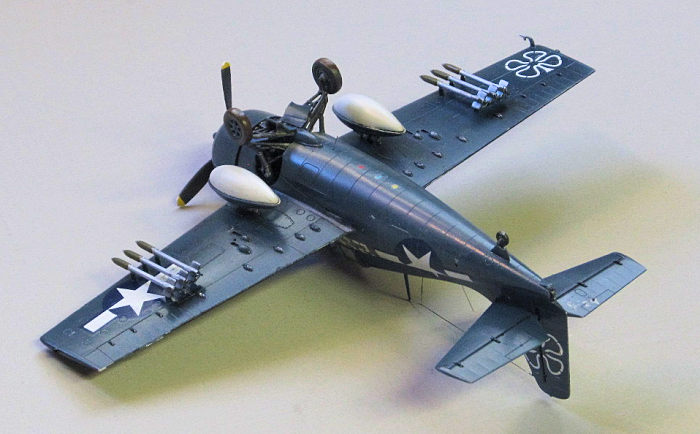 Arma Hobby kit reviewed here makes such questionable displays of nerdy
masculinity unnecessary. As for 1/72 Wildcats in general, most modelers these
days would probably narrow the choice down between this Arma kit and that from
New Airfix, as Hasegawa's with its empty wheel well, narrow canopy, and high
price tag has probably edged itself out.
Arma Hobby kit reviewed here makes such questionable displays of nerdy
masculinity unnecessary. As for 1/72 Wildcats in general, most modelers these
days would probably narrow the choice down between this Arma kit and that from
New Airfix, as Hasegawa's with its empty wheel well, narrow canopy, and high
price tag has probably edged itself out.
Two sprues in light grey and one in clear make up the parts, plus a very clear instruction booklet and decals (with comprehensive stencils inside and out plus markings for the rockets) for two USN Gloss Sea Blue aircraft. All parts are quite fine and the scribed detail is petite in the extreme. Fuselage panels are scribed and not lapped as on the real thing, though in 1/72 this isn't noticeable. A set of drop tanks and HVARs is provided, and the canopy is supplied as a set of two pieces—no alternate parts for open or closed posing. The clear plastic is sparkling and free of distortion. Gun ports are lined up the correct horizontal plane. This kit is available in both "Basic" and "Expert" releases, similar to Eduard's "Weekend Edition" and "Profipack" products in that the former in both cases does not include masks, photoetch parts, or possible resin, and is a lower price. More on this later. Also, in common with all other Wildcat kits in this scale, there's no detail in the engine accessory section forward of the main landing gear. More on this as well.
| CONSTRUCTION |
Fit is quite precise throughout, so there's really not much to report regarding construction. Except this: the Wildcat's stupendously complex landing gear and retraction system is represented by ten delicately in-scale components which require very, very careful cleanup, handling, and assembly, especially the step which concerns parts A11 and A12. My Flex-I-File Professional Sanding Frame was indispensable here to get the parting line in all those little nooks and crannies removed.
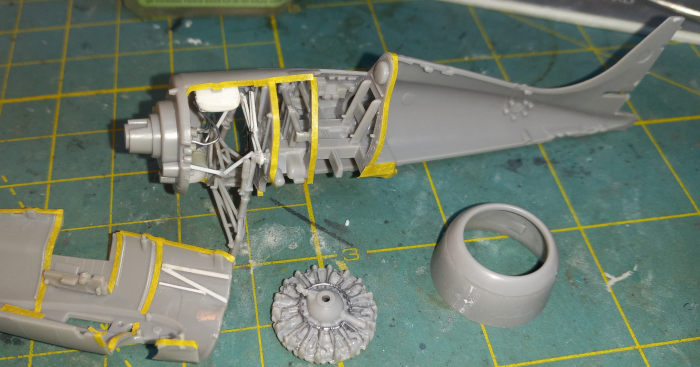 I mentioned the lack
of detail in the engine side of the gear well. This manifests itself as a sort
of "nothingness" forward of the landing gear through those gaping gear openings.
No kit in 1/72 has ever tried to pick this fight, which should be a surprise to
no one as the area on the real thing is a mess of wiring, tubing, and ducts, but
I'm a little surprised that the aftermarket industry didn't jump on the
opportunity. Especially as Eduard took it upon itself to release a complete set
of exhaust ducting for this kit which will be invisible once enclosed in the
model. Back in the day True Details put out a complete resin gear well for the
Hasegawa kit to correct a similar problem in that release, but even if you can
find one and adapt it it'll be no help as it was for the very different
accessory configuration of a P&W-powered aircraft. So I simply did a little
sleuthing on the Interweb and spent a couple of mornings filling up the space
with oil tank, engine rear, intercooler and ducting, and a few other frames and
bits. Nothing too intense; just some bits and bobs to fill up the otherwise
empty space.
I mentioned the lack
of detail in the engine side of the gear well. This manifests itself as a sort
of "nothingness" forward of the landing gear through those gaping gear openings.
No kit in 1/72 has ever tried to pick this fight, which should be a surprise to
no one as the area on the real thing is a mess of wiring, tubing, and ducts, but
I'm a little surprised that the aftermarket industry didn't jump on the
opportunity. Especially as Eduard took it upon itself to release a complete set
of exhaust ducting for this kit which will be invisible once enclosed in the
model. Back in the day True Details put out a complete resin gear well for the
Hasegawa kit to correct a similar problem in that release, but even if you can
find one and adapt it it'll be no help as it was for the very different
accessory configuration of a P&W-powered aircraft. So I simply did a little
sleuthing on the Interweb and spent a couple of mornings filling up the space
with oil tank, engine rear, intercooler and ducting, and a few other frames and
bits. Nothing too intense; just some bits and bobs to fill up the otherwise
empty space.
Because
of the odd structural interdependence that was produced by all these parts, I
also did something I never, ever would do otherwise: I completed the gear
assembly and installed it before I'd joined the fuselage halves. This allowed me
to paint and weather the gear well without gunking it up with smeared glue later
on. As I mentioned above, the main gear parts are quite fine and fiddly and
require a bit of modification here and there to go together correctly, so it was
nice to have it all done while still generally accessible for painting, and it
really didn't get in the way of assembly.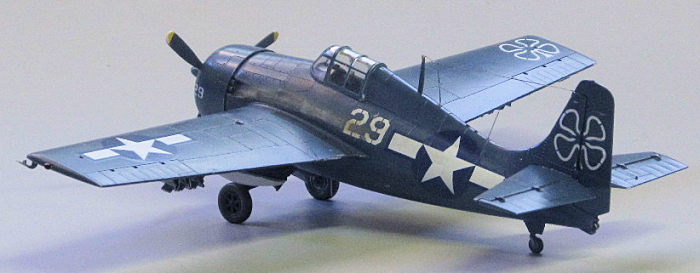
The only other items I spent any time with were scratch building some sprockets and bicycle chains for the landing gear retraction mechanism, carefully opening up the oil cooler ducts between the engine cylinders, and putting in some ignition wiring with fine solder. All these bits are supplied in photoetch in the more expensive Expert set. I'm on the fence regarding the qualities of accessories/no-accessories kits, but because of these Wildcat-specific peculiarities, combined with the fact that I ended up buying a separate canopy masking set anyway, I really recommend in this instance that you get the Expert release.
Waylaying myself with the gear well like that probably tripled the otherwise rapid construction time, but it was worth it. The rest of the model went together with no issues except a bit more time spent on the rocket fins, which are molded with an annoying seam line spanwise down each. The canopy parts fit well whether or not you choose it open or closed.
| COLORS & MARKINGS |
USN Gloss Sea Blue is a finish
I'm never quite sure
if I've gotten right. As mentioned, both options are this scheme, so I left off
the rockets and main wheels, masked off the canopy, landing gear & well, and
engine. I then shot a coat of Xtracolor Gloss Sea Blue over my new favored
primer, Tamiya white decanted from its spray bo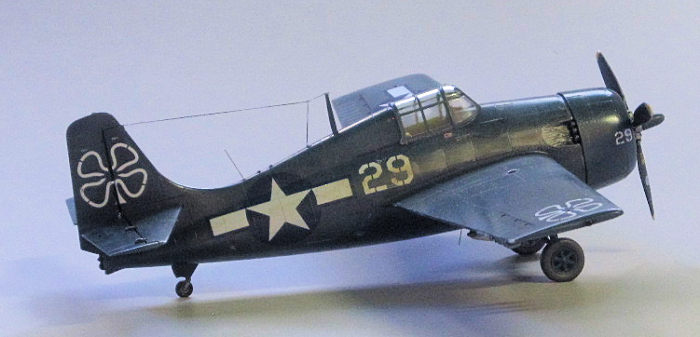 mb
and cut 50/50 with Randolph Butyrate Dope thinner.
mb
and cut 50/50 with Randolph Butyrate Dope thinner.
Decals went straight on over the glossy Xtracolor paint. These seemed to respond much better to the surface detail when I underlaid them with a drop of Micro Sol, and of course there's that compound curve of the fuselage sides: you might want to place three or four radial slices into the star of the national insignia if you want to avoid gently sanding away a few tiny wrinkles when they're dry.
After a clear coat, selected wash and highlighting, a set of exhaust streaks went on with oil paints and pastels. I'm moving away from the airbrush for this application, as this more relaxing approach allows far more control and precision. I start with the darker, sooty brown streak, let that dry for a day, then add the lighter white-tan streaking on top of that, then after that dries finish with very dark gray pastels for detail, usually immediately behind the exhaust outlets. This was then locked in under flat clear acrylic.
| CONCLUSIONS |
Excellent kit. If you're looking to specifically build an FM-2 the choice is a no-brainer, but that landing gear assembly is still a challenge for any modeler. Want any Wildcat and deciding between the Airfix and Arma offerings? Detail on this product is much finer than on the Airfix kit, though at the expense of fiddlier construction, and you don't get the folded-wing or gear-up options that Airfix provides. If you're new to the hobby or simply hate dealing with tiny parts and delicate assemblies, go for the British product. But if you don't mind that sort of refined work which requires intense concentration, plenty of light, and magnification, then by all means go with this Arma Hobby kit—and get the Expert set. You'll want the masks, and as one of the Truly Afflicted, already don't mind the wee little parts.
I'm already thinking about getting Arma's -4 to backdate to a -3, with those ginormous early-war markings.
| REFERENCES |
Kinzey, Bert. F4F & FM Wildcat in detail & scale. Independent Publication, 2018. ISBN# 978-1-7291197-5-4
Linn, Don. F4F Wildcat in action. Squadron-Signal Publications, 1988. ISBN# 0-89747-200-4
Ryan Grosswiler
17 May 2024
Copyright ModelingMadness.com. All rights reserved. No reproduction in part or in whole without express permission from the editor.
If you would like your product reviewed fairly and fairly quickly, please contact the editor or see other details in the Note to Contributors.